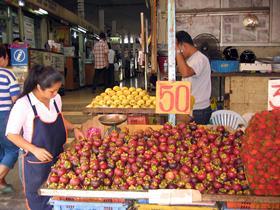
China's appetite for tropical fruit has risen sharply in the last couple of years, with almost 50 per cent of imports originating from Thailand.
A mix of proximity, preferential tariffs and the quality of Thai produce is helping drive remarkable export growth figures.
Thai fresh and frozen fruit sending to China grew 117 per cent year on year in 2011, representing 4 per cent of GDP in the Thai agricultural sector, the Bangkok Post has reported.
The largest volumes were for durian, banana, mango and mangosteen.
The Chinese are enthusiastic consumers of fresh fruit – consumption is estimated at 149kg per head per year, twice the global average – and, although they are one of the world's main producers, imports have been growing due to the expansion of the nation's middle class, which is driving demand, improvements to domestic distribution systems and, most importantly, the dissolution of tariffs under the China-Asean Free Trade Agreement.
Growth in Thailand's exports of fresh and frozen fruits to China averaged below 10 per cent a year before 2003; since tariffs were eliminated that year, shipments of both fruit and vegetables have grown by an average of more than 25 per cent a year.
There is strong potential to expand overland transport services, which currently move only 7 per cent of Thai fresh produce coming into the country.
The memorandum of understanding (MoU) the two countries signed in 2011 on the general administration of quality supervision, quarantine and inspection has had a major impact on this.
In the first nine months of 2012, overland exports of Thai fruit grew 44 per cent on the year before, outperforming total exports, which rose 25 per cent.
Overland shipments are made via the 1,100km Route R3A, which begins in Thailand's Chiang Rai province and passes through Laos before reaching Kunming, in China's southern province of Yunnan.
Since the MoU, there has been a reduction of transshipment times and improved efficiency along this route.
Road transport from Bangkok to Kunming can cost as much as Bt120,000 (US$3,900) per 20ft shipping container, but tends to be a door-to-door service and takes just two days to deliver.
Sea freight and inland water transport, via the Mekong River, are cheaper but longer services, unsuitable for perishable goods.
Sea shipments from Laem Chabang to Guangzhou or Shanghai cost less than Bt50,000 for a 20ft reefer container and take 5-7 days; river transport from Chiang Saen to Jinghong costs roughly Bt45,000 per 20ft container and takes 3-4 days.
River boats are hindered by low water levels during the dry season and are also barred by dams in northern stretches of the Mekong River.
The opening of the fourth Thai-Laos Friendship Bridge at Chiang Khong in December will be a game-changer, boosting the appeal of land transport via Route R3A.
The crossing promises an opportunity for logistics service providers to build facilities on-site for shipping fruit.
Already, transit trade via Laos to China at Chiang Khong has grown rapidly: in 2011 exports there grew 186 per cent year on year, the highest growth rate among all of Thailand's crossings.
As a key link in Route R3A, there is a plan to turn Chiang Khong into a special economic zone, with multi-modal freight facilities to enhance the efficiency of logistics activities at the border.
The further development of Yunnan as a gateway to South East Asia and the formation of the Asean Economic Community in 2015 will generate a huge increase in cargo transport volumes along the North-South Economic Corridor, especially between Thailand, Laos and China.
Together with the increasing consumer demand for Thai fruits, these factors create good opportunities for the development in Chiang Khong of cold-chain warehouses, distribution centres and specialised logistics services that will reduce inventories, transit times and fleet idle times – ultimately helping to reduce overall logistics costs.
Advanced climate-controlled and cold-chain logistics businesses are clearly needed to serve transit trade in perishable goods.
The percentage of fruit and vegetables among shipments through cold-chain logistics is only 30-40 per cent in Thailand, while it is around 80-85 per cent in developed countries.
As demand for freshness and quality grows, so too will the demand for cold-chain logistics services in the area.
It is expected that overland shipments of Thai fresh fruit exports to China will rise sharply in the near future.
Clever logistics businesses will prepare to offer integrated services to accommodate this growth.



